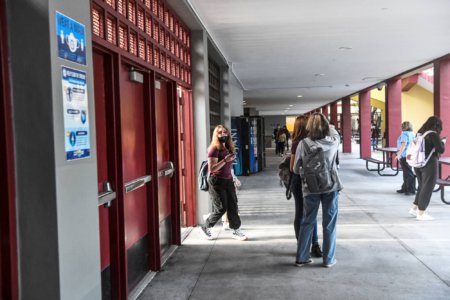
“From my own knowledge of these things, physics is not something that girls tend to fancy. They don’t want to do it … There’s a lot of hard maths in there that I think that they would rather not do,” Katharine Birbalsingh, chair of the UK government’s Social Mobility Commission and a secondary school head teacher, told the Commons Science and Technology Committee on April 27, 2022.
Comments like this are extremely disappointing. There are multiple reasons why girls don’t choose to study physics at A-level or for a degree – and “not wanting to do maths” is not one of them.
Instead, the reasons include getting less support from teachers and parents and stereotypes about who generally takes these subjects.
Comparing achievement
Birbalsingh commented that “hard maths” was stopping girls taking physics. If this were the case, though, we would expect to see far fewer girls taking maths. However, in 2019, 39% of A Level exam entrants in maths were girls, compared to 23% in physics. This shows that the reasons girls don’t take physics has more to do with physics than maths.
What’s more, girls and boys achieve similar grades in maths and physics. In 2019 – the last year standard exams were set – 8.5% of girls achieved an A* in Physics A-level compared to 8.8% of boys; 28.7% of girls and 27.6% of boys scored an A grade. The same pattern can be seen in GCSE results. But more boys than girls choose to go on to study science at a higher level.
The ASPIRES project has followed a group of students from the age of 10 to young adulthood, studying their ambitions related to science. The project has found that, throughout secondary school, boys are more likely than girls to say they would like to become a scientist. This difference increased over the course of secondary school, with the biggest gap being found in year 13.
There is evidence that the expectations placed on pupils by teachers plays a large role in which students go on to take physics at higher levels. The ASPIRES project found that from ages 10 to 18, boys were significantly more likely than girls to say that their teacher expected them to do well in science, and to feel that their teacher was interested in whether they understood science. The research found that girls often did not feel “clever enough” to do physics, even though girls achieve similar grades to boys.
Gender sterotypes
In physics the stereotype is that boys are naturally better at it than girls, and this messaging is still being passed on (both intentionally and unintentionally) to our young people in school, in their home lives and through the media. A well-known example is the television show the Big Bang Theory, which features four male physicists and engineers and their ditsy female neighbour.
These findings are backed up by the Institute of Physics’ (IOP) Limit Less report, which found that girls are often told that physics is more suited to boys.
Another report by the IOP shows that in single-sex schools a greater proportion of girls took physics than in coeducational schools, across both the state and private school system. In environments where gendered messaging is lessened, the participation rate of girls increases.
It is vitally important to remove the barriers to girls’ participation in physics. We are part of the South East Physics Network (SEPnet), a collaboration of nine university physics departments working together to promote excellence in physics with a focus on diversity.
At SEPnet we created the Shattering Stereotypes programme in 2017 to raise awareness among students of gendered stereotyping in subject choice, and equip them with tools to be resilient to this. We also provide teacher training in this area to support teachers’ awareness of the damage gender stereotypes and gendered language can have, and to provide them with resources and tools to combat them.
The IOP runs multiple projects to address the gender imbalance in physics. Their Limit Less campaign supports young people from all backgrounds to fulfil their potential by doing physics. The Improving Gender Balance Project is a research project working with schools to identify ways to improve balance across the school environment.
In spite of all of this, Birbalsingh’s remarks show that we have a long way to go to normalise the idea that both girls and boys are capable of, and inherently interested in, studying physics. As a society, we need to shift our perceptions of the relationship between gender and STEM subjects such as physics.![]()
Olivia Keenan, SEPnet Director of Outreach and Public Engagement, School of Physical and Chemical Sciences, Queen Mary University of London and Jen Gupta, Senior Public Engagement and Outreach Fellow, University of Portsmouth
This article is republished from The Conversation under a Creative Commons license. Read the original article.










